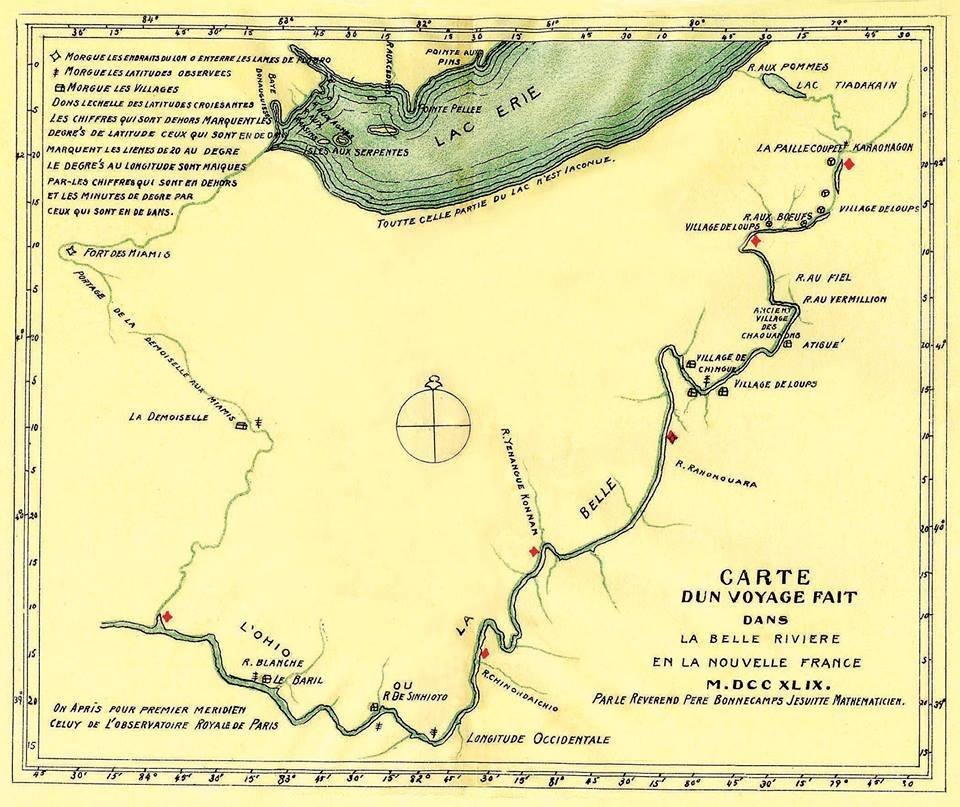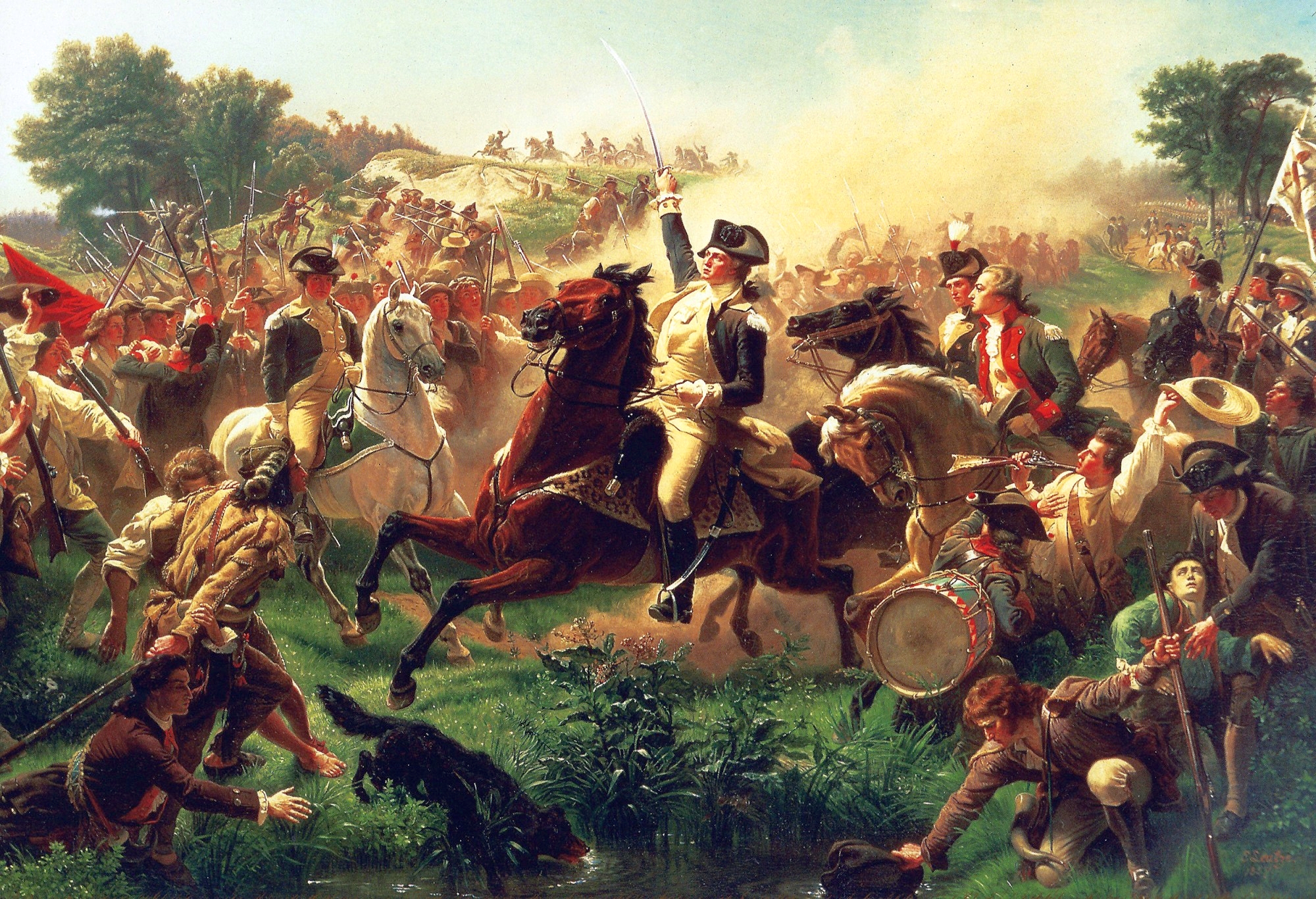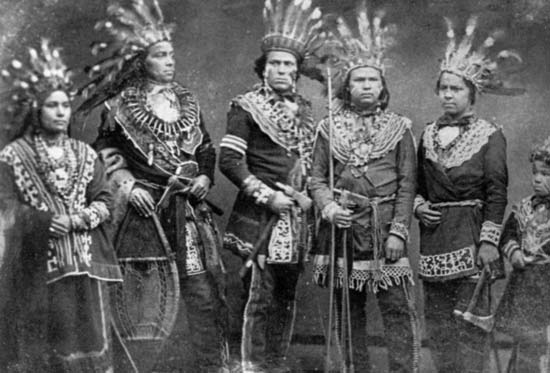|
Michel Maray De La Chauvignerie
Michel Maray de La Chauvignerie (January 24, 1704August 10, 1778), also known as Michel Maray, sieur de la La Chauvignerie, was a French military officer in the Troupes de la Marine and interpreter of Iroquoian languages. Biography Michel Maray de La Chauvignerie was born on January 24, 1704 in Montreal, New France to Sieur Louis Maray de la Chauvignerie, an officer in the Troupes de la Marine, and Catherine Joly. He was baptized in Montreal, New France on September 5, 1704. Together with Louis-Thomas Chabert de Joncaire, La Chauvignerie convinced several Native American tribes to renew their alliance with New France at a banquet in Montreal by singing an Iroquois war song when New France was threatened by an attack from the British in August 1711. In 1736, La Chauvignerie published a list of names from the Ojibwe and other peoples that he had compiled. In June 1755, Lieutenant La Chauvignerie replaced Philippe-Thomas Chabert de Joncaire as the officer in charge of constructing ... [...More Info...] [...Related Items...] OR: [Wikipedia] [Google] [Baidu] |
Montreal
Montreal ( ; officially Montréal, ) is the second-most populous city in Canada and most populous city in the Canadian province of Quebec. Founded in 1642 as '' Ville-Marie'', or "City of Mary", it is named after Mount Royal, the triple-peaked hill around which the early city of Ville-Marie is built. The city is centred on the Island of Montreal, which obtained its name from the same origin as the city, and a few much smaller peripheral islands, the largest of which is Île Bizard. The city is east of the national capital Ottawa, and southwest of the provincial capital, Quebec City. As of 2021, the city had a population of 1,762,949, and a metropolitan population of 4,291,732, making it the second-largest city, and second-largest metropolitan area in Canada. French is the city's official language. In 2021, it was spoken at home by 59.1% of the population and 69.2% in the Montreal Census Metropolitan Area. Overall, 85.7% of the population of the city of Montreal co ... [...More Info...] [...Related Items...] OR: [Wikipedia] [Google] [Baidu] |
Philippe-Thomas Chabert De Joncaire
Philippe-Thomas Chabert de Joncaire (), also known as Nitachinon by the Iroquois, was a French army officer and interpreter in New France who established Fort Machault in the 18th century. During his career, he largely served as a diplomat with the indigenous nations rather than as a soldier. Early life Philippe-Thomas Chabert de Joncaire was the eldest son of Louis-Thomas Chabert de Joncaire (1670–1739) and Marie-Madeleine Le Gay. He was baptized in Montreal on January 9, 1707. He was the older brother of Daniel-Marie Chabert de Joncaire de Clausonne. Joncaire was given by his father to the Seneca at the age of 10 and was raised by the Iroquois. Career Early career Joncaire joined the colonial French army in 1726 and attained the rank of second ensign in 1727. On July 23, 1731, he married Madeleine Renaud Dubuisson. In 1735, Joncaire succeeded his father as the principal interpreter and political agent from New France to the Iroquois. His responsibilities included ... [...More Info...] [...Related Items...] OR: [Wikipedia] [Google] [Baidu] |
Interpreters
Interpreting is a translational activity in which one produces a first and final target-language output on the basis of a one-time exposure to an expression in a source language. The most common two modes of interpreting are simultaneous interpreting, which is done at the time of the exposure to the source language, and consecutive interpreting, which is done at breaks to this exposure. Interpreting is an ancient human activity which predates the invention of writing. However, the origins of the profession of interpreting date back to less than a century ago. History Historiography Research into the various aspects of the history of interpreting is quite new. For as long as most scholarly interest was given to professional conference interpreting, very little academic work was done on the practice of interpreting in history, and until the 1990s, only a few dozen publications were done on it. Considering the amount of interpreting activities that is assumed to have occurre ... [...More Info...] [...Related Items...] OR: [Wikipedia] [Google] [Baidu] |
French Army Officers
French (french: français(e), link=no) may refer to: * Something of, from, or related to France ** French language, which originated in France, and its various dialects and accents ** French people, a nation and ethnic group identified with France ** French cuisine, cooking traditions and practices Fortnite French places Arts and media * The French (band), a British rock band * "French" (episode), a live-action episode of ''The Super Mario Bros. Super Show!'' * ''Française'' (film), 2008 * French Stewart (born 1964), American actor Other uses * French (surname), a surname (including a list of people with the name) * French (tunic), a particular type of military jacket or tunic used in the Russian Empire and Soviet Union * French's, an American brand of mustard condiment * French catheter scale, a unit of measurement of diameter * French Defence, a chess opening * French kiss, a type of kiss involving the tongue See also * France (other) * Franch, a surna ... [...More Info...] [...Related Items...] OR: [Wikipedia] [Google] [Baidu] |
1778 Deaths
Events January–March * January 18 – Third voyage of James Cook: Captain James Cook, with ships HMS ''Resolution'' and HMS ''Discovery'', first views Oahu then Kauai in the Hawaiian Islands of the Pacific Ocean, which he names the ''Sandwich Islands''. * February 5 – **South Carolina becomes the first state to ratify the Articles of Confederation. ** **General John Cadwalader shoots and seriously wounds Major General Thomas Conway in a duel after a dispute between the two officers over Conway's continued criticism of General George Washington's leadership of the Continental Army.''Harper's Encyclopaedia of United States History from 458 A. D. to 1909'', ed. by Benson John Lossing and, Woodrow Wilson (Harper & Brothers, 1910) p166 * February 6 – American Revolutionary War – In Paris, the Treaty of Alliance and the Treaty of Amity and Commerce are signed by the United States and France, signaling official French recognition of th ... [...More Info...] [...Related Items...] OR: [Wikipedia] [Google] [Baidu] |
1704 Births
Seventeen or 17 may refer to: * 17 (number), the natural number following 16 and preceding 18 * one of the years 17 BC, AD 17, 1917, 2017 Literature Magazines * ''Seventeen'' (American magazine), an American magazine * ''Seventeen'' (Japanese magazine), a Japanese magazine Novels * ''Seventeen'' (Tarkington novel), a 1916 novel by Booth Tarkington *''Seventeen'' (''Sebuntiin''), a 1961 novel by Kenzaburō Ōe * ''Seventeen'' (Serafin novel), a 2004 novel by Shan Serafin Stage and screen Film * ''Seventeen'' (1916 film), an American silent comedy film *''Number Seventeen'', a 1932 film directed by Alfred Hitchcock * ''Seventeen'' (1940 film), an American comedy film *'' Eric Soya's '17''' (Danish: ''Sytten''), a 1965 Danish comedy film * ''Seventeen'' (1985 film), a documentary film * ''17 Again'' (film), a 2009 film whose working title was ''17'' * ''Seventeen'' (2019 film), a Spanish drama film Television * ''Seventeen'' (TV drama), a 1994 UK dramatic short starring Chr ... [...More Info...] [...Related Items...] OR: [Wikipedia] [Google] [Baidu] |
Battle Of Fort Niagara
The Battle of Fort Niagara was a siege late in the French and Indian War, the North American theatre of the Seven Years' War. The British siege of Fort Niagara in July 1759 was part of a campaign to remove French control of the Great Lakes and Ohio Valley regions, making possible a western invasion of the French province of Canada in conjunction with General James Wolfe's invasion to the east. Background British General Jeffery Amherst made plans for the 1759 military campaigns of the Seven Years' War that included an expedition to capture Fort Niagara, a major French military and supply point between the French province of Canada and their forts in the Ohio Valley. Amherst chose Brigadier General John Prideaux to lead the expedition, which also included Sir William Johnson, the British Indian agent who led the expedition's Iroquois forces. Fort Niagara had been largely constructed under the direction of Captain Pierre Pouchot of the French Army. In early 1759, General Lou ... [...More Info...] [...Related Items...] OR: [Wikipedia] [Google] [Baidu] |
Fort Niagara
Fort Niagara is a fortification originally built by New France to protect its interests in North America, specifically control of access between the Niagara River and Lake Ontario, the easternmost of the Great Lakes. The fort is on the river's eastern bank at its mouth on Lake Ontario. Youngstown, New York, later developed near here. The British took over the fort in 1759 during the French and Indian War. Although the United States was ostensibly ceded the fort after it gained independence in the American Revolutionary War, the British stayed until 1796. Transfer to the U.S. came after signing of the Jay Treaty that reaffirmed and implemented the legal border with British Canada. Although the US Army deactivated the fort in 1963, the Coast Guard continues to have a presence here. A non-profit group operates the fort and grounds as a state park and preserves it in part as a museum and site for historical re-enactments. It is also a venue for special events related to the region' ... [...More Info...] [...Related Items...] OR: [Wikipedia] [Google] [Baidu] |
French And Indian War
The French and Indian War (1754–1763) was a theater of the Seven Years' War, which pitted the North American colonies of the British Empire against those of the French, each side being supported by various Native American tribes. At the start of the war, the French colonies had a population of roughly 60,000 settlers, compared with 2 million in the British colonies. The outnumbered French particularly depended on their native allies. Two years into the French and Indian War, in 1756, Great Britain declared war on France, beginning the worldwide Seven Years' War. Many view the French and Indian War as being merely the American theater of this conflict; however, in the United States the French and Indian War is viewed as a singular conflict which was not associated with any European war. French Canadians call it the ('War of the Conquest').: 1756–1763 The British colonists were supported at various times by the Iroquois, Catawba, and Cherokee tribes, and the French ... [...More Info...] [...Related Items...] OR: [Wikipedia] [Google] [Baidu] |
François-Marie Le Marchand De Lignery
François-Marie Le Marchand de Lignery (24 August 1703 – 29 July 1759) was a colonial military leader in the French province of Canada. Active in the defense of New France during the Seven Years' War (also known as the French and Indian War), he died of wounds sustained in the 1759 Battle of La Belle-Famille. Life Born into a military family (his father was Constant le Marchand de Lignery, an officer of the French colonial military) in Montreal, Lignery enrolled as a cadet in the troupes de la marine at 14, and first saw service in 1728 during the Fox Wars.Russ He also saw service in the Chickasaw Wars and King George's War, where he participated in attacks on Fort Anne and Grand Pré. In 1751 he was promoted to captain.Russ When the French and Indian War broke out, Lignery played an important role in the French defense of the Ohio Country. He distinguished himself in the defeat of Braddock in 1755, in which his company held the French center while Indians and ... [...More Info...] [...Related Items...] OR: [Wikipedia] [Google] [Baidu] |
Ojibwe
The Ojibwe, Ojibwa, Chippewa, or Saulteaux are an Anishinaabe people in what is currently southern Canada, the northern Midwestern United States, and Northern Plains. According to the U.S. census, in the United States Ojibwe people are one of the largest tribal populations among Native Americans in the United States, Native American peoples. In Canada, they are the second-largest First Nations in Canada, First Nations population, surpassed only by the Cree. They are one of the most numerous Indigenous peoples of the Americas, Indigenous Peoples north of the Rio Grande. The Ojibwe population is approximately 320,000 people, with 170,742 living in the United States , and approximately 160,000 living in Canada. In the United States, there are 77,940 mainline Ojibwe; 76,760 Saulteaux; and 8,770 Mississauga, organized in 125 bands. In Canada, they live from western Quebec to eastern British Columbia. The Ojibwe language is Ojibwe language, Anishinaabemowin, a branch of the Algonquia ... [...More Info...] [...Related Items...] OR: [Wikipedia] [Google] [Baidu] |




.jpg)

